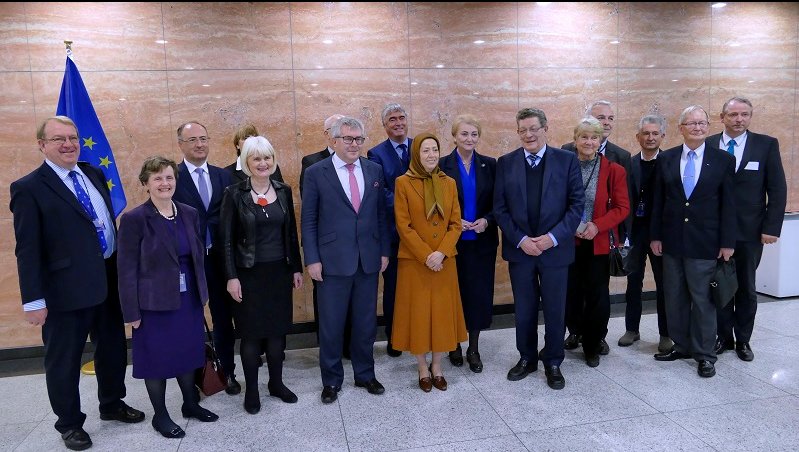
European Lawmakers led by , Ryszard Czarnecki the then Vice President of the European Parliament receive Maryam Rajavi, the President-elect of the Iranian Opposition for a meeting on the occasion of the Human Rights Day in the European Parliament-06 December 2017
On Tuesday, January 15th, a former European Minister of Poland and sitting Member of the European Parliament, Ryszard Czarnecki, penned an op-ed for International Policy Digest. The piece, entitled ‘Western Leaders Must Join Iranian Activists in Recognizing Their Movement’s Potential’, calls on governments around the world to lend their support to the only viable democratic alternative in Iran, the National Council of Resistance of Iran (NCRI), led by Maryam Rajavi, the president-elect of the Iranian opposition, which the People’s Mujahedin Organisation of Iran (MEK) is the principal member to.
A Mobilised Population
Czarnecki praised the work of the Iranian resistance units operating inside Iran to promote the Iranian resistance movement. They have worked tirelessly, “placing posters in public places throughout Tehran and other cities, identifying martyrs by name and reiterating the slogans associated with their cause.”
The President-elect Maryam Rajavi was acutely aware of the capabilities of the resistance cells in Iran. Last year, she predicted a “year full of uprisings.” 2018 lived up to her predictions.
In 2018, there were a total of 9,596 individual protests, affecting all 31 of Iran’s provinces and more than 142 towns and cities.
As Maryam Rajavi predicted, 2018 was a pivotal moment for the Iranian opposition movement. For the first time, the mullahs seemed to acknowledge that the MEK was behind the surge in opposition protests. Supreme Leader Ali Khamenei blamed the MEK for the surge in street protests and pointed the finger at their shrewd use of social media to organise protests and connect their supporters as the source of their influence.
This represented a break from the regime’s traditional propaganda narrative which had maintained that the MEK was a fringe movement, with little to no support within Iran, “and incapable of affecting change on a large scale,” Czarnecki writes.
2019 is unlikely to provide the mullahs with any respite. In the opening days of the year, bank customers, municipal workers, and car buyers took to the streets to protest. The regime’s failure to address the economic crisis and its “chronic inattention to public welfare,” means that the conditions that gave rise to the protests in 2018 are still very much present in the Iranian landscape in 2019.
However, Czarnecki writes, “what is much less clear is whether the international community will prove similarly responsive.”
The Iranian Regime is a Threat to Western Democracy
The Iranian regime’s policies do not play out in a bubble and are not limited to Iran. The mullahs desire to influence regional politics make the clerical regime a threat to Western democracies and their national security interest.
Iran’s Islamic Revolutionary Guard Corps (IRGC) is active across the Middle East, including in Yemen, Syria, Iraq, and Lebanon. The mullahs have also been accused of funnelling money and weapons to militia groups across the region.
Czarnecki predicts, “the footprint of the Islamic Revolutionary Guard Corps will deepen all across the Middle East, and can affect the situation in the West, where foreign supporters of the PMOI (MEK) were targeted several times over the past year.”
Czarnecki is referring to the high-profile terrorist attacks that Iran’s Ministry of Intelligence (MOIS) planned in Paris, Albania, and the US, and the assassination plots that unfolded in the Netherlands and Denmark.
The regime has demonstrated that its actions are not limited to Iran, but place citizens from across the West at risk.
Recognition of the National Council of Resistance of #Iran, as the sole democratic alternative to the regime, is imperative to rectifying four decades of appeasement. These are essential steps in facing a regime which only understands the decisive language of force.#FreeIran pic.twitter.com/fWbFGIzrDs
— Maryam Rajavi (@Maryam_Rajavi) January 13, 2019
“The situation demands international attention, particularly in the form of economic sanctions and diplomatic isolation aimed at limiting the regime’s ability to project force beyond its borders and to crack down on dissent inside them,” Czarnecki writes.
The work of the MEK’s resistance units offers an opportunity for international opponents to the Iranian regime to facilitate meaningful change in Iran. While the protest movement is expanding, the Iranian regime is in a vulnerable position. Should the MEK receive “earnest and sustained support from the international community,” Czarnecki writes, “it may soon be able to achieve the long-sought goal of regime change.”
Staff Writer
